Huawei Technologies F361 Handset Phone User Manual manual
Huawei Technologies Co.,Ltd Handset Phone manual
User Manual

HUAWEI F361
USER GUIDE

Copyright © Huawei Technologies Co., Ltd. 2013. All rights reserved.
No part of this manual may be reproduced or transmitted in any form or by any
means without prior written consent of Huawei Technologies Co., Ltd. and its
affiliates ("Huawei").
The product described in this manual may include copyrighted software of Huawei
and possible licensors. Customers shall not in any manner reproduce, distribute,
modify, decompile, disassemble, decrypt, extract, reverse engineer, lease, assign,
or sublicense the said software, unless such restrictions are prohibited by
applicable laws or such actions are approved by respective copyright holders.
Trademarks and Permissions
, , and are trademarks or registered trademarks
of Huawei Technologies Co., Ltd.
Other trademarks, product, service and company names mentioned may be the
property of their respective owners.
Notice
Some features of the product and its accessories described herein rely on the
software installed, capacities and settings of local network, and therefore may not
be activated or may be limited by local network operators or network service
providers.
Thus, the descriptions herein may not exactly match the product or its accessories
which you purchase.
Huawei reserves the right to change or modify any information or specifications
contained in this manual without prior notice and without any liability.
DISCLAIMER
ALL CONTENTS OF THIS MANUAL ARE PROVIDED “AS IS”. EXCEPT AS
REQUIRED BY APPLICABLE LAWS, NO WARRANTIES OF ANY KIND, EITHER
EXPRESS OR IMPLIED, INCLUDING BUT NOT LIMITED TO, THE IMPLIED
WARRANTIES OF MERCHANTABILITY AND FITNESS FOR A PARTICULAR
PURPOSE, ARE MADE IN RELATION TO THE ACCURACY, RELIABILITY OR
CONTENTS OF THIS MANUAL.
TO THE MAXIMUM EXTENT PERMITTED BY APPLICABLE LAW, IN NO EVENT
SHALL HUAWEI BE LIABLE FOR ANY SPECIAL, INCIDENTAL, INDIRECT, OR
CONSEQUENTIAL DAMAGES, OR LOSS OF PROFITS, BUSINESS, REVENUE,
DATA, GOODWILL SAVINGS OR ANTICIPATED SAVINGS REGARDLESS OF
WHETHER SUCH LOSSES ARE FORSEEABLE OR NOT.
THE MAXIMUM LIABILITY (THIS LIMITATION SHALL NOT APPLY TO
LIABILITY FOR PERSONAL INJURY TO THE EXTENT APPLICABLE LAW
PROHIBITS SUCH A LIMITATION) OF HUAWEI ARISING FROM THE USE OF
THE PRODUCT DESCRIBED IN THIS MANUAL SHALL BE LIMITED TO THE
AMOUNT PAID BY CUSTOMERS FOR THE PURCHASE OF THIS PRODUCT.
Import and Export Regulations
Customers shall comply with all applicable export or import laws and regulations
and be responsible to obtain all necessary governmental permits and licenses in
order to export, re-export or import the product mentioned in this manual including
the software and technical data therein.
Privacy Policy
Please refer to our privacy policy on our websites for the information about how we
protect your personal information.
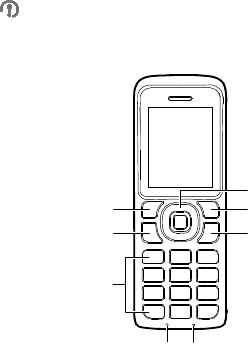
1
Getting Started
The figures in this document are provided only for your
reference. The phone that you have purchased may
differ from that shown.
Front View
2
3
1
6
8
7
45
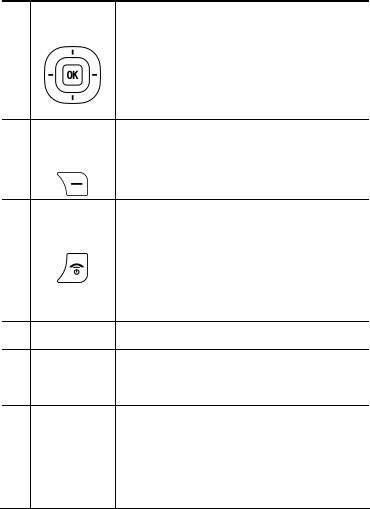
2
1
Navigation
keys
In standby mode, press OK to access
the main menu.
In standby mode, press a navigation
key to access specific shortcut menu.
During a call, press left or right
navigation key to adjust the call
volume.
2
Right
function
key
Press this key to select the menu option
in the lower right corner of the screen.
3
End key
End a call or reject an incoming call.
Press and hold this key to power on
or off the phone.
In standby mode, press this key to
turn on/off the display screen.
In non-standby mode, press this key
to return to standby mode.
4
Microphone
Microphone.
5
Power
indicator
The power indicator is steady red when
the phone is connected to a power
supply.
6
Number
and
Symbol
keys
Press the keys to input numbers or
characters.
Keys 1: In standby mode, press and
hold the 1 key to access voicemail.
Keys 2 to 9: In standby mode, press
and hold these keys for speed
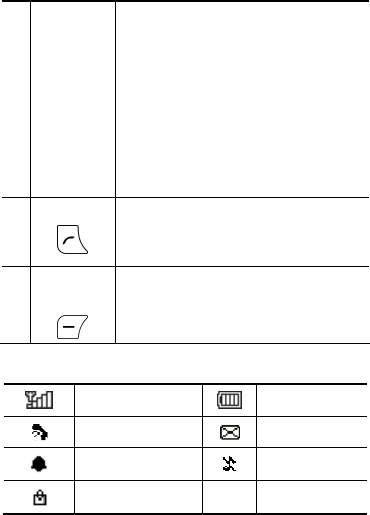
3
Icons
Signal strength
Battery level
Missed calls
Unread
messages
Alarm activated
Silent profile
activated
Keypad locked
dialing.
Key *:In edit mode, press this key to
open the symbol list. In standby
mode, activate or deactivate the
Silent profile by pressing and holding
this key in standby mode. When
keypad is locked, press left function
key and this key to unlock.
Key #:In edit mode, press this key to
switch the input method. In standby
mode, press and hold this key to lock
keypad.
7
Send key
Press this key to make or receive
calls.
In standby mode, press this key to
browse through the call history.
8
Left
function
key
Press this key to select the menu option
in the lower left corner of the screen.
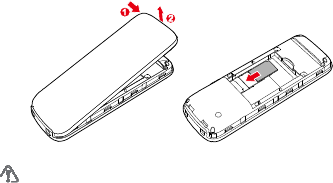
4
Installation
Installing the SIM Card
Before installing the SIM card, ensure that the phone is
powered off and disconnected from the power adapter.
When installing the SIM card, ensure that the gold contact area
faces down, that the beveled edge of the SIM card aligns with
that of the SIM card slot, and that the SIM card is fully inserted.
Do not frequently remove or insert the SIM card when
using the phone.
Installing the Battery
Before installing the battery, ensure that the phone is powered
off and disconnected from the power adapter. Ensure that the
battery is correctly installed and that the battery poles are not
reversed.
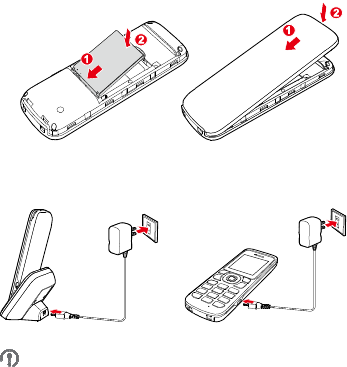
5
Charging the Battery
Method 1:
Method 2:
If you plan to leave the phone unused for a long
period, you must remove the battery from the
phone.
The battery supplies power for only a limited
period. Ensure that the battery has been fully
charged before using the phone without the line
power supply connected.
If your battery power is exhausted or the battery
is unused for a long period, the phone screen
may not be able to light up when you charge the
battery. This is normal. The phone will be ready
for use after being charged for a while.

6
Powering On the Phone
To power the phone on, press and hold the until the
screen lights up.
In standby mode, press and hold to power off the
phone.
Call Functions
Making a Call
1. In standby mode, press the number keys to input the
phone number.
2. Press to call the number.
3. Press to end a call or cancel the dialing.
In standby mode, press
to view the call
history. Select number and press to make
the call.
In Phonebook, select a contact and press
to make the call.
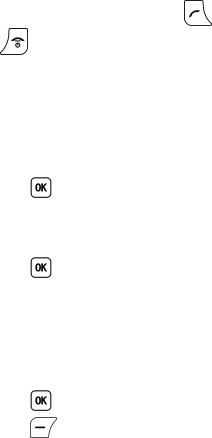
7
Answering or Rejecting a Call
When there is an incoming call, press to answer the call;
press to reject the call.
Message
Creating a Message
1. Select Message > New message.
2. Write the message.
3. Press and then add a recipient using the following
methods:
Enter the recipient's phone number.
Add the recipient from the phonebook.
4. Press
to send the message.
Reading a Message
The phone stores received messages in the inbox.
1. Select Message > Inbox.
2. Press the up or down navigation key to scroll to a
message in the list.
3. Press
to read the message.
4. Press to manage the message.

8
Input Methods
Switching Between Input Methods
In edit mode, press
#
##
#
key to switch between text input methods.
In edit mode, press to delete the character
to the left of the cursor, press and hold to
delete all characters.
In the s ABC or s abc input mode, press 0 key to
enter a space. In the ABC, abc or Abc input
mode, press 0 key once to enter a space, twice to
enter “0”.
In any input mode, press * key to open symbol
list.
s ABC/s abc
Enter a word in s ABC or s abc input mode, do the following
steps:
1. Press the keys labeled with the letters required to spell the
desired word once according to the spelling sequence of
the word.
As you enter letters, the phone attempts to predict the
desired word and displays candidate words.
2. Press up or down navigation key
to select the desired
word.
3. Press the left or right navigation key to confirm the
selection and press to enter the word.
You can also press the 0 key to confirm the selection to
enter the word followed by a space.

9
ABC/abc
In ABC or abc input method, press the number keys to enter
letters. Press a number key repeatedly until the desired
character appears. If the next letter you want to enter is on the
same key as the current one, wait until the current letter is
entered, and then enter the next one.
123
In 123 input method, press number keys to input numbers.
In s ABC/s abc/ABC/abc input method, press and hold a
number key to enter the number.
Symbols
1. In any input mode, press * key to display a symbol list.
2. Press the navigation key to select the desired symbol.
3. Press to enter the symbol.
FM Radio (Optional)
To listen to the radio, select Tools > FM radio. Press the left or
right navigation key to change channel, press the up or down
navigation key to decrease or increase the volume.
You can select Options for the following options:
Channel list: To display the channel list.
Manual input: To input a frequency manually.
Auto search: To search channels automatically.
Settings: To set whether to play the radio in background.
Power: To turn the FM radio on/off.

10
Settings
Phone Lock
To set the phone lock, select Settings > Security settings >
Phone security. You can change the default code (1234) to
any number string of four to eight digits.
When restoring the phone to factory settings, you must
enter the correct phone lock code.
Keypad Lock
In standby mode, press and hold # key to lock the keypad.
When the keypad is locked, press first, and then press *
key to unlock the keypad.
If automatic keypad lock function is activated, the keypad is
automatically locked when the phone leaves unused for a
period longer than the preset period in standby mode.
PIN and PUK
Personal identification number (PIN) code helps effectively
prevent unauthorized use of your SIM card.
Personal unblocking key (PUK) code helps change the locked
PIN code.
If you enter the wrong PIN code for three times, your SIM card
will be locked. In this case, you need to enter the PUK code to
unblock the locked PIN code.
PIN code and PUK code are provided together with the SIM
card. For details, consult your service provider.
11
Warnings and Precautions
This section contains important information about the operation
of your device. It also contains information about how to use
the device safely. Read this information carefully before using
your device.
Electronic Device
Power off your device when use is prohibited. Do not use the
device if doing so causes danger or interference with other
electronic devices.
Accessories
Using an unapproved or incompatible charger or battery
may cause fire, explosion or other hazards.
Choose only batteries, chargers, and accessories approved
for use with this model by the device manufacturer. The use
of any other types of batteries, chargers, or accessories may
void the warranty, may violate local regulations and laws,
and may be dangerous. Please contact your retailer for
information about the availability of approved batteries,
chargers, and accessories in your area.
Charger safety
Unplug the charger from electrical outlets and the device
when not in use.
If the power cable is damaged (for example, the cord is
exposed or broken), or the plug loosens, stop using it at
once. Continued use may lead to electric shocks, short
circuits, or fire.
Do not drop or cause an impact to the charger.
Do not touch the power cord with wet hands or pull the
power cord to disconnect the charger.
12
If your device has been exposed to water, other liquids, or
excessive moisture, take it to an authorized service center
for inspection.
For pluggable devices, the socket-outlet shall be installed
near the devices and shall be easily accessible.
Battery safety
Do not connect battery poles with conductors, such as keys,
jewelry, or other metal materials. Doing so may short-circuit
the battery and cause injuries or burns.
Do not solder battery poles or dismantle the battery. Doing
so may lead to electrolyte leakage, excessive heat, fire, or
explosion.
Keep the battery away from excessive heat and direct
sunlight. Do not place it on or in heating devices, such as
microwave ovens, stoves, or radiators. Batteries may
explode if overheated.
Do not attempt to modify or remanufacture the battery, insert
foreign objects into it, or immerse or expose it to water or
other liquids. Doing so may lead to fire, explosion, or other
hazards.
If the battery leaks, ensure that the electrolyte does not
make direct contact with your skins or eyes. If the electrolyte
touches your skins or splashes into your eyes, immediately
flush with clean water and consult a doctor.
In case of battery deformation, color change, or overheating
while charging or storing, immediately stop using the device
and remove the battery. Continued use may lead to battery
leakage, fire, or explosion.
Do not put batteries in fire as they may explode. Damaged
batteries may also explode.
Do not drop the device or battery. If the device or battery is
dropped, especially on a hard surface, and may be
damaged, take it to an authorized service center for
inspection.
13
Improper battery use may lead to fire, explosion, or other
hazards.
Dispose of used batteries in accordance with local
regulations.
Do not smash or pierce the battery, or expose it to high
external pressure. Doing so may lead to a short circuit or
overheating.
If the battery is improperly replaced, it may explode. Recycle
or dispose of used batteries according to local regulations or
refer to your device instructions.
If the device standby and talk time shortens significantly,
replace the battery.
Operating environment
Avoid dusty, damp, or dirty environments. Avoid magnetic
fields. Using or charging your device in these environments
may result in circuit malfunctions.
Do not use your device during thunderstorms to protect your
device against any danger caused by lightning.
Connect the device only to products with the USB-IF logo or
with USB-IF compliance program completion.
Observe local laws and regulations, and respect the privacy
and legal rights of others.
Avoid touching the antenna when you are on a call.
Touching the antenna affects call quality, increases power
consumption, and reduces talk and standby time.
Ideal operating temperatures are 0°C to 45°C. Ideal
storage temperatures are -20°C to 60°C. Extreme heat or
cold may damage your device or accessories.
Do not expose your device to direct sunlight (such as on a
car dashboard) for prolonged periods.
Do not place your device or batteries on or in heating
devices, such as microwave ovens, stoves, water heaters,
or radiators. Batteries may explode if overheated.
14
Stop using your device or applications for a while if the
device is overheated. If skin is exposed to an overheated
device for an extended period, low temperature burn
symptoms, such as red spots and darker pigmentation, may
occur.
Do not use your device’s camera flash directly in the eyes of
people or pets. Otherwise temporary loss of vision or
damage to the eyes may occur.
Do not allow children or pets to bite or suck the device or
battery. Doing so may result in damage or explosion.
Child's safety
Comply with all precautions with regard to child's safety.
Letting children play with the device or its accessories may
be dangerous. The device includes detachable parts that
may present a choking hazard. Keep away from children.
The device and its accessories are not intended for use by
children. Children should only use the device with adult
supervision.
Interference with medical equipment
Follow rules and regulations set forth by hospitals and health
care facilities. Do not use your device where prohibited.
Pacemaker manufacturers recommend that a minimum
distance of 15 cm be maintained between a device and a
pacemaker to prevent potential interference with the
pacemaker. If using a pacemaker, hold the device on the
side opposite the pacemaker and do not carry the device in
your front pocket.
Some wireless devices may affect the performance of
hearing aids or pacemakers. Consult your service provider
for more information.
Areas with flammables and explosives
Do not use the device where flammables or explosives are
stored (in a gas station, oil depot, or chemical plant, for
15
example). Using your device in these environments
increases the risk of explosion or fire. In addition, follow the
instructions indicated in text or symbols.
Do not store or transport the device in containers with
flammable liquids, gases, or explosives.
Traffic security
Observe local laws and regulations while using the device. If
using the device while driving a vehicle, observe the following
guidelines:
Concentrate on driving. Your first responsibility is to drive
safely.
Do not hold the device while driving. Use hands-free
accessories.
When you must make or answer a call, pull of the road
safely and park the vehicle first.
RF signals may affect the electronic systems of motor
vehicles. For more information, consult the vehicle
manufacturer.
Do not place the device over the air bag or in the air bag
deployment area in a motor vehicle. Doing so may hurt you
because of the strong force when the air bag inflates.
Do not use your device while flying in an aircraft. Power off
your device before boarding. Using wireless devices in an
aircraft may disrupt wireless networks, present a hazard to
aircraft operation, or be illegal.
Cleaning and maintenance
Before you clean or maintain the device, power it off, and
disconnect it from the charger.
Do not use any chemical detergent, powder, or other
chemical agents (such as alcohol and benzene) to clean the
device or charger. These substances may cause damage to
parts or present a fire hazard. Use a clean, soft, and dry
cloth to clean the device and charger.

16
Keep the device and accessories dry. Protect them from
water and humidity. Do not touch the device or the charger
with wet hands. Doing so may lead to short circuits,
malfunctions, or electric shocks.
Avoid collision, which may lead to battery leakage, device
malfunctions, overheating, fire, or explosion.
Do not place magnetic storage media, such as magnetic
cards and floppy disks, near the device. Radiation from the
device may erase the information on magnetic storage
media.
Do not expose your device, battery, or charger to extreme
heat or cold. These environments may interfere with proper
function and may lead to fire or explosion. Battery
performance is affected at temperatures lower than 0°C.
Do not place sharp metal objects, such as pins, near the
earpiece or speaker. The earpiece may attract these objects
and result in injury.
Do not dismantle the device or accessories. This voids the
warranty and releases the manufacturer from liability for
damage.
If the device screen is broken in a collision, immediately stop
using the device. Do not touch or attempt to remove the
broken parts. Promptly contact an authorized service center.
Emergency calls
The availability of emergency calls is subject to your cellular
network quality, service provider policy, and local laws and
regulations. Never rely solely on your device for critical
communications like medical emergencies.
Disposal and recycling information
This symbol (with or without a solid bar) on the
device, batteries (if included), and/or the
packaging, indicates that the device and its
electrical accessories (for example, a headset,
17
adapter, or cable) and batteries should not be disposed of as
household garbage. These items should not be disposed of as
unsorted municipal waste and should be taken to a certified
collection point for recycling or proper disposal.
For more detailed information about device or battery recycling,
contact your local city office, household waste disposal service,
or retail store.
Disposal of the device and batteries (if included) is subject to
WEEE Directive Recast (Directive 2012/19/EU) and Battery
Directive (Directive 2006/66/EC). The purpose of separating
WEEE and batteries from other waste is to minimize the
potential environmental impacts and human health risk of any
hazardous substances that may be present.
Reduction of hazardous substances
This device is compliant with the REACH Regulation
[Regulation (EC) No 1907/2006] and RoHS Directive Recast
(Directive 2011/65/EU). Batteries (if included) are compliant
with the Battery Directive (Directive 2006/66/EC). For
up-to-date information about REACH and RoHS compliance,
please visit the web site www.huaweidevice.com/certification.
EU regulatory conformance
Body worn operation
The device complies with RF specifications when used near
your ear or at a distance of X cm from your body. Ensure that
the device accessories, such as a device case and device
holster, are not composed of metal components. Keep the
device away from your body to meet the distance requirement.
Certification information (SAR)
This device meets guidelines for exposure to radio waves.
Your device is a low-power radio transmitter and receiver. As
recommended by international guidelines, the device is
designed not to exceed the limits for exposure to radio waves.

18
These guidelines were developed by the International
Commission on Non-Ionizing Radiation Protection (ICNIRP), an
independent scientific organization, and include safety
measures designed to ensure the safety of all users, regardless
of age and health.
The Specific Absorption Rate (SAR) is the unit of measurement
for the amount of radio frequency energy absorbed by the body
when using a device. The SAR value is determined at the
highest certified power level in laboratory conditions, but the
actual SAR level during operation can be well below the value.
This is because the device is designed to use the minimum
power required to reach the network.
The SAR limit adopted by Europe is 2.0 W/kg averaged over 10
grams of tissue, and the highest SAR value for this device
complies with this limit.
The highest SAR value reported for this device type when
tested at the ear is X.XX W/kg, and when properly worn on the
body is X.XX W/kg.
Statement
Hereby, Huawei Technologies Co., Ltd. declares that this
device is in compliance with the essential requirements and
other relevant provisions of Directive 1999/5/EC.
For the declaration of conformity, visit the web site
www.huaweidevice.com/certification.
The following marking is included in the product:
0
979
Notice: This device may be operated in all member states of
the EU.
Notice:
19
Observe national and local regulations where the device is
used.
This device may be restricted for use, depending on the local
network.
FCC Regulatory Compliance
Body worn operation
The device complies with RF specifications when used near
your ear or at a distance of 5 mm from your body. Ensure that
the device accessories, such as a device case and device
holster, are not composed of metal components. Keep the
device away from your body to meet the distance requirement.
This device is also designed to meet the requirements for
exposure to radio waves established by the Federal
Communications Commission (USA).
The SAR limit adopted by the USA is 1.6 W/kg averaged over
one gram of tissue. The highest SAR value reported to the FCC
for this device type complies with this limit.
The highest SAR value reported to the FCC for this device type
when tested for use at the ear is 1.441 W/kg, when properly
worn on the body is 1.276 W/kg.
FCC statement
This equipment has been tested and found to comply with the
limits for a Class B digital device, pursuant to Part 15 of the
FCC Rules. These limits are designed to provide reasonable
protection against harmful interference in a residential
installation. This equipment generates, uses and can radiate
radio frequency energy and, if not installed and used in
accordance with the instructions, may cause harmful
interference to radio communications. However, there is no
guarantee that interference will not occur in a particular
installation. If this equipment does cause harmful interference
to radio or television reception, which can be determined by

20
turning the equipment off and on, the user is encouraged to try
to correct the interference by one or more of the following
measures:
--Reorient or relocate the receiving antenna.
--Increase the separation between the equipment and receiver.
-- Connect the equipment into an outlet on a circuit different
from that to which the receiver is connected.
-- Consult the dealer or an experienced radio/TV technician for
help.
This device complies with Part 15 of the FCC Rules. Operation
is subject to the following two conditions: (1) this device may
not cause harmful interference, and (2) this device must accept
any interference received, including interference that may
cause undesired operation.
Any changes or modifications to this device not expressly
approved by Huawei Technologies Co., Ltd. for compliance
could void the user's authority to operate the equipment.
Please visit www.huaweidevice.com/worldwide/support/hotline
for recently updated hotline and email address in your country
or region.
96721777_01